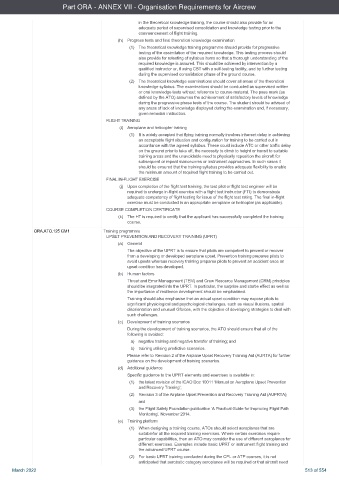Page 513 - UK AirCrew Regulations (Consolidated) March 2022
P. 513
Part ORA - ANNEX VII - Organisation Requirements for Aircrew
in the theoretical knowledge training, the course should also provide for an
adequate period of supervised consolidation and knowledge testing prior to the
commencement of flight training.
(h) Progress tests and final theoretical knowledge examination
(1) The theoretical knowledge training programme should provide for progressive
testing of the assimilation of the required knowledge. This testing process should
also provide for retesting of syllabus items so that a thorough understanding of the
required knowledge is assured. This should be achieved by intervention by a
qualified instructor or, if using CBT with a self-testing facility, and by further testing
during the supervised consolidation phase of the ground course.
(2) The theoretical knowledge examinations should cover all areas of the theoretical
knowledge syllabus. The examinations should be conducted as supervised written
or oral knowledge tests without reference to course material. The pass mark (as
defined by the ATO) assumes the achievement of satisfactory levels of knowledge
during the progressive phase tests of the course. The student should be advised of
any areas of lack of knowledge displayed during the examination and, if necessary,
given remedial instruction.
FLIGHT TRAINING
(i) Aeroplane and helicopter training
(1) It is widely accepted that flying training normally involves inherent delay in achieving
an acceptable flight situation and configuration for training to be carried out in
accordance with the agreed syllabus. These could include ATC or other traffic delay
on the ground prior to take off, the necessity to climb to height or transit to suitable
training areas and the unavoidable need to physically reposition the aircraft for
subsequent or repeat manoeuvres or instrument approaches. In such cases it
should be ensured that the training syllabus provides adequate flexibility to enable
the minimum amount of required flight training to be carried out.
FINAL IN-FLIGHT EXERCISE
(j) Upon completion of the flight test training, the test pilot or flight test engineer will be
required to undergo in-flight exercise with a flight test instructor (FTI) to demonstrate
adequate competency of flight testing for issue of the flight test rating. The final in-flight
exercise must be conducted in an appropriate aeroplane or helicopter (as applicable).
COURSE COMPLETION CERTIFICATE
(k) The HT is required to certify that the applicant has successfully completed the training
course.
ORA.ATO.125 GM1 Training programme
UPSET PREVENTION AND RECOVERY TRAINING (UPRT)
(a) General
The objective of the UPRT is to ensure that pilots are competent to prevent or recover
from a developing or developed aeroplane upset. Prevention training prepares pilots to
avoid upsets whereas recovery training prepares pilots to prevent an accident once an
upset condition has developed.
(b) Human factors
Threat and Error Management (TEM) and Crew Resource Management (CRM) principles
should be integrated into the UPRT. In particular, the surprise and startle effect as well as
the importance of resilience development should be emphasised.
Training should also emphasise that an actual upset condition may expose pilots to
significant physiological and psychological challenges, such as visual illusions, spatial
disorientation and unusual Gforces, with the objective of developing strategies to deal with
such challenges.
(c) Development of training scenarios
During the development of training scenarios, the ATO should ensure that all of the
following is avoided:
a) negative training and negative transfer of training; and
b) training utilising predictive scenarios.
Please refer to Revision 2 of the Airplane Upset Recovery Training Aid (AURTA) for further
guidance on the development of training scenarios.
(d) Additional guidance
Specific guidance to the UPRT elements and exercises is available in:
(1) the latest revision of the ICAO Doc 10011 ‘Manual on Aeroplane Upset Prevention
and Recovery Training’;
(2) Revision 3 of the Airplane Upset Prevention and Recovery Training Aid (AUPRTA);
and
(3) the Flight Safety Foundation publication ‘A Practical Guide for Improving Flight Path
Monitoring’, November 2014.
(e) Training platform
(1) When designing a training course, ATOs should select aeroplanes that are
suitablefor all the required training exercises. Where certain exercises require
particular capabilities, then an ATO may consider the use of different aeroplanes for
different exercises. Examples include basic UPRT or instrument flight training and
the advanced UPRT course.
(2) For basic UPRT training conducted during the CPL or ATP courses, it is not
anticipated that aerobatic category aeroplanes will be required or that aircraft need
March 2022 513 of 554

